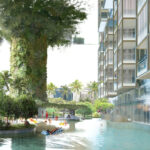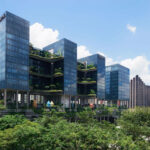Innovative climate-friendly vertical housing pitched at boomers

LONDON: Innovative climate-friendly vertical housing options are increasingly being pitched at baby boomers.
It’s the classic overwater bungalow experience: stepping directly from your balcony into the waters that lap your lodgings. Only, this “bungalow” is on the fifth floor of a skyscraper and the view beyond the palm trees is not an island-studded ocean but the high-rises of Singapore’s bustling Orchard Road.
The beach loft suites are only one of the remarkable things about the 347-room Pan Pacific Orchard, one of the most eye-catching hotels to open this year. Seen from a distance, the building’s startling silhouette resembles a reconfigured S, thanks to a number of cut-out terraces including not just the fifth-floor Beach Terrace but also a leafy Forest Terrace; a Garden Terrace complete with manicured plantings and fountains; and a Cloud Terrace with mirror pools.
Each one offers a high-rise outdoor retreat where guests can relax above the busy Singapore streets.
The 23-storey tower, created by Singaporean architecture firm WOHA, also features 120-metre high plant-covered pillars and is remarkable not only for its construction – those terraces are made of lightweight steel attached to a concrete skeleton – but also for its sustainability measures.
The building has been certified BCA Green Mark Platinum and includes technology such as solar panels, rainwater harvesting and the bio-digester system that transforms food waste. Every element of the design also helps to promote sustainability, including those striking cut-outs.
“By having the huge sky terraces as overhang, we bring in plenty of natural daylight and natural ventilation, which reduces the need for air-conditioning,” says WOHA’s Hong Wei Phua. And the site’s extensive plantings – more than twice the site’s total footprint – help purify the air while reducing the heat going into the building.
“We are trying to push the boundary in terms of what we can do,” says Phua.
At stake is a lot more than just making waves in the design world. This type of cutting-edge urban design just might help tip the balance in the fight against global warming. Cities consume 78 per cent of the world’s energy and produce more than 60 per cent of greenhouse gas emissions, despite covering less than 2 per cent of Earth’s surface, according to UN-Habitat. Making cities more sustainable is therefore a key way to meet climate goals.
One of the most urbanised countries on the planet, Singapore started rethinking its approach to urban design years ago. It introduced green building standards in 2008, followed in 2009 by the Landscaping for Urban Spaces and High-Rises initiatives, usually referred to as LUSH.
Two years ago, the government introduced the Green Plan 2030, which set bold targets including greening 80 per cent of the city’s buildings by gross floor area, planting a million more trees to absorb CO2 and setting aside more land for nature parks.
Older landmarks include the undulating Henderson Waves walkway. Crafted from a local hardwood called balau and stretching across the lush Southern Ridges area, it gives locals an immersion in nature without impacting the delicate landscape beneath. A network of new hiking tracks, such as a 62-kilometre cross-island trail linking Changi and Tuas, is set to open next year.
Ultimately, however, it is green buildings that will play a vital role in Singapore’s transformation from being a garden city to what Kwan Ok Lee describes as “a city in garden”. Lee, associate professor and Dean’s Chair of Urban Planning at the Business School at the National University of Singapore (NUS), says one of the key tasks for Singaporean architects is finding ways to reduce the city-state’s energy consumption.
“The energy usage per person is usually very high in a tropical country because it’s so very hot; we have the air conditioning on most of the time,” she says.
Lee’s employer, the National University of Singapore, scored the Green Mark Platinum Champion Award for its work in creating low-energy and zero-energy buildings.
The city’s top-tier office spaces are also greening quickly but other sectors, such as residential, are lagging. Lee says high-profile hotels can be an example to the rest of the property market.
“Hotel [owners] know that travellers are looking for more sustainable behaviour, so for them the upfront investment is a simpler decision, compared with a resident looking for an apartment who may not want to pay an extra 5 per cent for a green building,” she says.
WOHA is responsible for many of Singapore’s greenest hotels, including the Oasia Downtown, another plant-covered building that operates without mechanical ventilation and has 10 times more greenery that the park it replaced. Equally eye-catching is the Parkroyal Collection Pickering, which featured on a set of Skyrise Greenery stamps issued by the government.
Incorporating so much greenery into buildings does present challenges, not least because high-rise gardens are much harder to maintain than their terrestrial equivalents. For the Pan Pacific Orchard, Phua says the key was to keep things simple.
“We wanted planting that is as natural as possible instead of a manicured landscape, so we selected predominantly native species that will thrive with good light and water. We planted greenery on each tier that will climb up one storey, which keeps maintenance low-tech.”
In a world where the effects of climate change are becoming more evident every day, Singapore shows how government and the private sector can encourage each other. Lee points out that Singapore’s ambitious green guidelines do more than help protect the planet.
“This urban planning approach attracts more tourists and also upgrades the city’s image,” she says. “We see a lot of government officials and scholars visiting to learn about how Singapore has done it. We have had many people from America, Japan, Korea, China, a lot of Middle Eastern countries – but not many from Australia.”
- The beach club on the fifth floor at the Pan Pacific Orchard in Singapore
- The Garden Terrace has manicured plantings and fountains. A suite is 68 square metres. | Pan Pacific Orchard in Singapore
- The Parkroyal Collection Pickering hotel opened in 2013 and featured on a set of stamps









